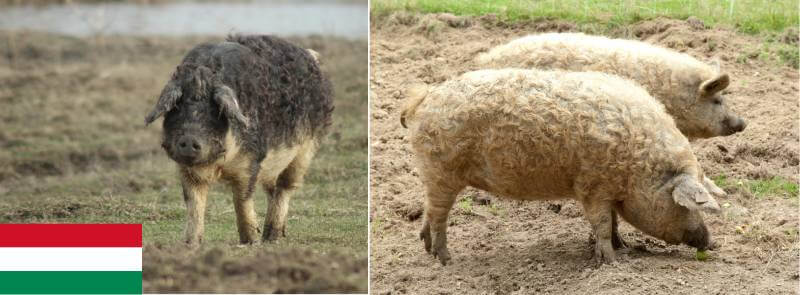
The Mangalica pig breed, also known as Mangalitsa, Mangalitza, or Bruce, is particularly recommended for homesteading and small farms. But this is not a rule. Anyone who wants to add a bit of diversity to their livestock can raise them.
Mangalica pigs are used for their meat in meat production and for their lard. They are most known for their high-quality meat, which is considered a delicacy, and for their long and curly hair.
Additionally, they are known for their docile behavior and independent and self-sufficient nature, making them an excellent choice for those who want to raise pigs without too much work.
This article presents in detail all the necessary information about the Mangalica pig breed, including its characteristics, growth rate, behavior, feeding, and meat, as well as tips on how to raise it or purchase a purebred.
Is the wooly pig breed a good choice for you? Let’s explore.
Contents
What is a Mangalica pig?
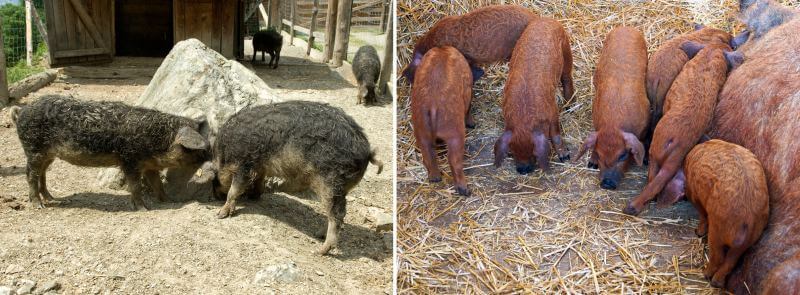
Mangalica is a domestic pig with origins in Hungary. The Mangalica pig breed is considered a heritage breed and appeared through crossbreeding various pig breeds from Romanian Salonta, Hungarian Bakony, and Serbian Šumadija in the mid-19th century.
Mangalica pigs were close to extinction in the 1990s, with less than 200 pigs in Hungary.
However, they are becoming popular again among farmers and breeders who grow them not only in Hungary, but also in the United States, where they were exported in 2007, and the United Kingdom.
Mangalica Pig Characteristics
Physical Characteristics
Color
The Mangalica pig can be found in three color variations: blonde, red, and swallow-bellied.
The blonde Mangalica pig is entirely blonde, and the red Mangalica is a ginger-colored pig. The swallow-bellied Mangalica has the lower part of the body blonde, while the upper part of the body is black.

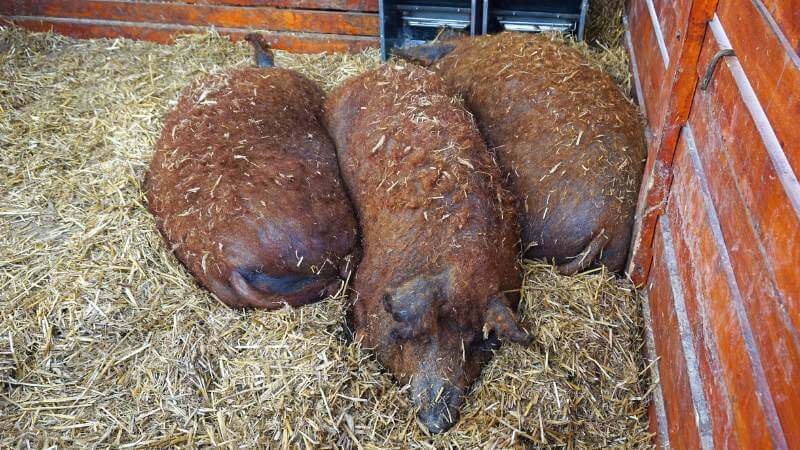
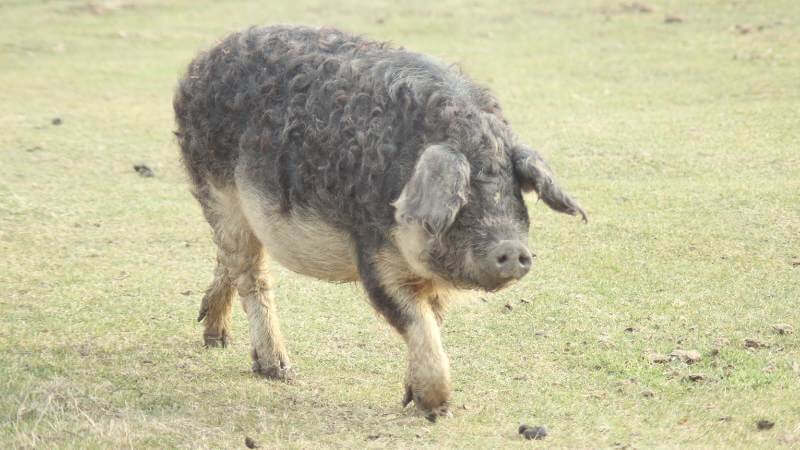
Hair
The Mangalica pig has a thick, curly coat that is more similar to a woolly coat, like that of a sheep.
But can you shear Mangalica pig? No, it is not recommended to shear a Mangalica pig because their hair is their natural protection against various factors.
Mangalica pigs have lots of hair because they were specially created in the mid-19th century to survive the cold temperatures of the region in Hungary. Not only that, but their hair also protects them from sun rays, wind, and rain.
The Mangalica hair does not require grooming. Also, the hair has no significant usage.
** Mangalica pig is the only hairy breed that has been preserved. All the others got extinct.
Size
These pigs have a medium body size.

An adult male Mangalica pig can reach a body length of 37.40 inches, measured from the tip of the nose to the starting point of the tail.
In contrast, an adult female Mangalica pig measures around 36.22 inches in length.
Body
Mangalica’s body is uniform in shape and has a well-muscled appearance.
Normally, a Mangalica pig has at least five fully developed nipples on each side of its body.
As for the ribs, Mangalica pigs have two ribs less than any other breed.
Head
The head is small and rounded compared to the rest of the body, while the ears are small and hang close to the face, near the eyes.
Legs
The legs are not particularly short or long, but they are relatively wide, which allows them to support the weight of the body well.
Lifespan
Mangalica pigs can live for 15 to 20 years. Compared with other pig breeds, Mangalica’s lifespan is quite long.
Growth Rate
How fast do Mangalica pigs grow?
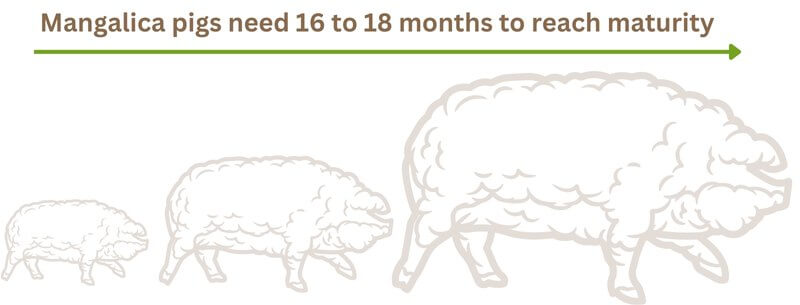
Mangalica pigs need 16 to 18 months to reach maturity. These pigs do not grow at the same rate as other pig breeds.
In comparison to typical commercial or heritage pig breeds, the growth period of Mangalica pigs is double.
Generally, it takes 8 to 10 months for a commercial pig to reach its optimal weight, which is half the time needed for a Mangalica pig to reach its weight.
Weight
Mangalica pigs can weigh up to 250-275 lbs when they reach maturity at 16-18 months of age. During the growth stage, the daily weight gain averaged 11 oz. per day.
At birth, Mangalica piglets typically weigh between 21 to 35 oz. and can reach a weight of 13 to 18 lbs within 7-8 weeks. However, this is less than the weight gained by other pig breeds.
If Mangalica pigs are allowed to fatten for a longer period, they can reach a weight of up to 440-660 lbs. On average, the pigs gain 16 oz. per day during the fattening stage.
Slaughter Time
Mangalica pigs can be slaughtered at 16 to 18 months of age.
However, they can also be slaughtered earlier if they have reached the desired weight. The typical hanging weight of a Mangalica pig is between 150 to 175 lbs.
Temperament and Behaviour
Mangalica pigs have great temperament and behavior and are known as the breed that acts like dogs.
They are calm, friendly, and social, with an overall docile nature. They enjoy socializing with other pigs, animals, and people. They love to walk around people and follow them on pasture.
What’s fascinating about Mangalica is their exceptional memory. They can learn quickly, pick up hints, and learn faster than dogs because they are more focused. They also remember faces, recognizing the person that feeds them or animals that bully them.
In general, they are easy to work with and rarely show signs of tantrums or aggression, only becoming aggressive when they feel threatened or stressed.
Do male Mangalica pigs need to be castrated?
Yes, it is recommended to castrate male Mangalica pigs at a very young age for the purpose of obtaining high-quality meat rather than changing their behavior.
Apart from their friendly behavior and temperament, Mangalica pigs are excellent natural foragers, and rooting and foraging are part of their behavior.
Mangalica Meat
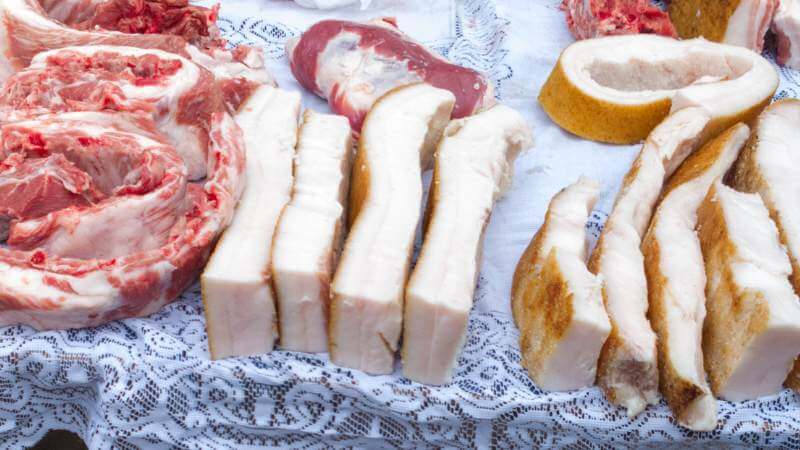
Mangalica pigs have a carcass of 65 to 70% fat and only 30 to 35% lean meat, making them one of the fattiest pig breeds in the world.
Despite this, Mangalica meat is renowned as “the Kobe of Pork” due to its incredible taste. It is considered one of the tastiest pig meats in the world, being tender and extremely juicy thanks to its high-fat content.
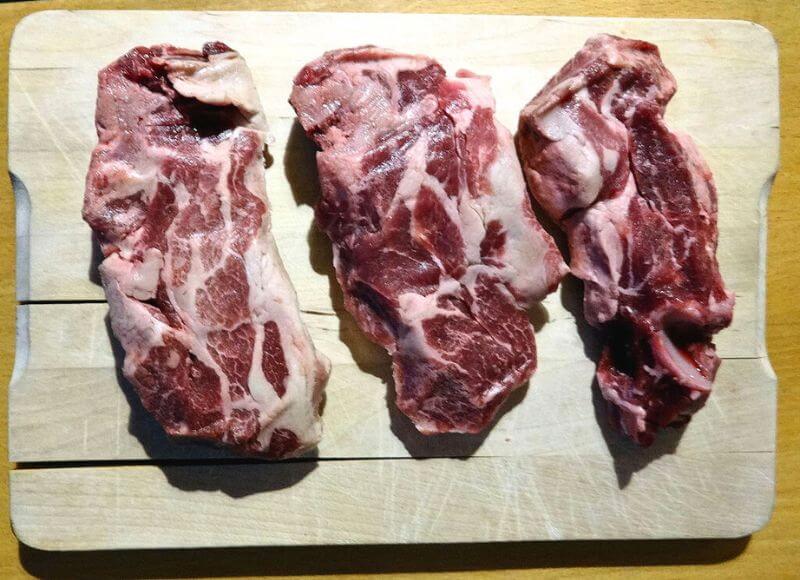
The fat or lard of Mangalica pigs is different from that of other pigs, as it contains a larger amount of unsaturated fat, less saturated fat, and no trans fat. Mangalica lard is so soft that it starts melting at room temperature, making it easier for your body to process it.
Saturated and unsaturated fatty acids in back fat of several modern pig breeds and Mangalica
In addition to the lard, Mangalica meat has a rich, deep red color and is highly marbled with soft, white fat. It is also packed with nutrients such as Omega-3 fatty acids, vitamin B1 (thiamine), zinc, and other natural antioxidants and minerals. The taste is very complex and the texture is extremely juicy.
Mangalica meat is commonly used in the production of various meat products such as pancetta, salami, sausages, and more. The main cuts of the Mangalica pig used in meat production are the head, loin, sirloin, ham, bacon, ribs, and shoulder.
Below you can find the nutritional values of the Mangalica meat.
| Nutrient | Amount per 100g |
|---|---|
| Calories | 278 kcal |
| Fat | 21 g |
| Saturated Fat | 8.1 g |
| Protein | 19 g |
| Sodium | 47 mg |
| Cholesterol | 71 mg |
| Iron | 1.7 mg |
| Zinc | 2.5 mg |
| Vitamin B12 | 0.7 μg |
| Components | Fat, g/100g | Cholesterol, mg/100g |
|---|---|---|
| Pork leg | 8.0 | 50 |
| Chop | 9.5 | 54 |
| Neck | 17 | 55 |
| Muscles | 21 | 67 |
| Lard | 80 | 130 |
Growing Mangalica Pig
Feeding Mangalica Pig
To have healthy and thriving Mangalica pigs, it is important to offer them the right feed that satisfies their general nutritional needs.
Mangalica pigs are excellent grazers and can root for themselves quite well. This makes them a great choice for homesteaders or small farmers who are looking for pigs to help them manage pastures.
Due to their grazing habits, they require only half the quantity of feed that a regular pig would need, making them the perfect choice for those looking to achieve sustainability in farming.
So, what should you feed Mangalica pigs?
During the grazing season, Mangalica pigs can take most of their nutrients from the pasture. For example, during the summer, they obtain their vitamin E, which is essential for pigs, from grass.
In general, you can feed Mangalica pigs with grubs, roots, various types of grass, legumes, black walnuts, chestnuts, and acorns. You can also add to their diet rolled barley, alfalfa pellets, field peas, sunflower seeds, wheat bran, pumpkin, boiled eggs, and potatoes
In dry climates, you can prepare their food by soaking it in water for 8 to 10 hours before feeding them.
Soaking the feed well in water keeps them hydrated and decreases their water intake.
Although they do not require a lot of supplemental feed, it is important to include a small amount in their diet because they cannot develop optimally on grazing alone, as demonstrated by Barbara Meyer’s experiment in Altenschildesche near Almere, Holland.
In this experiment, five Mangalica pigs were released into a wild area with rich vegetation for seven months.
However, they did not have enough protein in their diet from grazing alone.
What about the cold season? During winter, Mangalica pigs require more supplemental feed than during the grazing season. You must ensure that they are well-fed and do not have a deficiency of vitamin E.
You can include:
- boiled eggs
- potatoes
- peanuts
- rolled barley
- field peas
- alfalfa pellets
- some kelp for minerals
Furthermore, you can use the winter season to plan what to plant in your garden for the next warm season to provide good grazing feed for these pigs.
You can plant:
- hazelnuts
- mulberry
- black locust
- Siberian pea shrub
- alfalfa, which you can also use during the winter.
What not to feed Mangalica pigs
You should not feed Mangalica pigs corn and soy, especially if you are aiming to produce high-quality meat and fat.
This type of feed decreases the quality of meat and fat and can also cause digestive issues in the pigs.
Mangalica Pigs Water Intake
Mangalica pigs, like any other pig, require a stable supply of fresh water. They need to have water at their disposal to grow healthy. Water is an important element in pig farming, whether it’s a small homestead or a larger farm.
Environment
Mangalica pigs should be raised in a free environment, which is why they are an excellent choice for homesteaders and small to medium farmers. These pigs need ample space to graze, run, and explore. They thrive in outdoor environments.
While they can be raised in commercial pig farms, they do not typically thrive in such conditions. This type of environment can not provide the necessary outdoor space that these pigs need to stay healthy and happy.
Therefore, smaller farms and homesteads are better suited for raising Mangalica pigs.
The only tool you need to keep and control Mangalica pigs in their designated area is an electric fence. With this tool, the pigs will not be able to escape beyond the fence.
Climate
Mangalica pigs can thrive in a variety of climates, including both cold and warm environments. They can adapt to a wide range of environmental conditions.
In colder climates, Mangalica pigs are protected from the cold by their thick hair, which keeps them warm.
In warmer environments, they tend to shed more hair, but their remaining hair still protects from sunburn. Mangalica pigs have been successfully raised in warmer areas such as Florida and California.
Overall, there are no limitations on where you can raise Mangalica pigs, making them a great choice for farmers in diverse regions.
Shelter
Mangalica pigs need shelter in certain weather conditions. While they generally do well outdoors, even in cold temperatures, they need shelter during severe wind conditions or extremely low temperatures in the winter season.
So, what kind of shelter is suitable for Mangalica pigs?
One option is to install portable steel huts that are fixed securely over a plywood bottom and filled with plenty of straw. This type of shelter provides enough protection in case of wind or low temperatures.
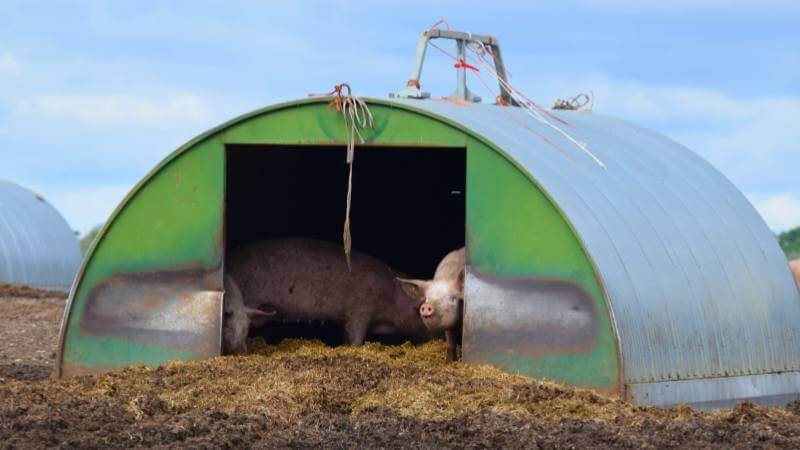
Another option is to construct a more permanent type of shelter using a solid wooden structure with posts placed every 8 to 10 feet and partial backfilling on the outside.
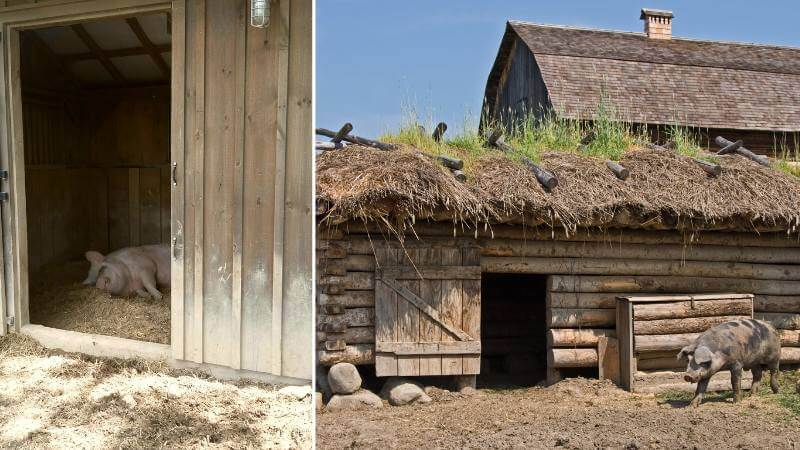
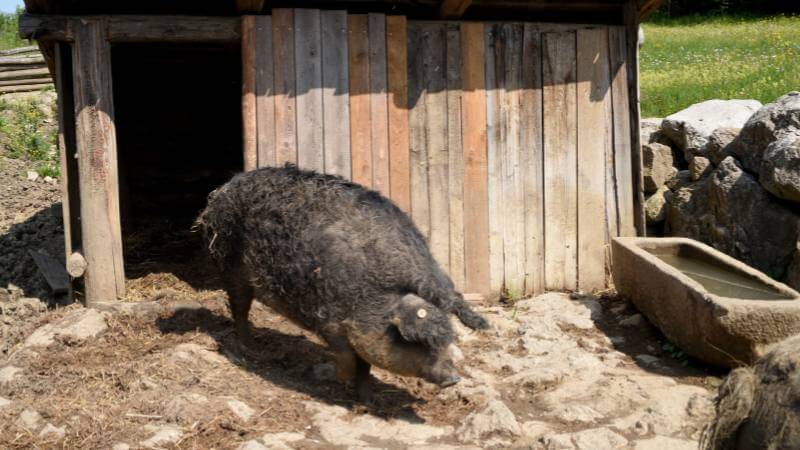
Overall, these simple structures are all that Mangalica pigs require in terms of shelter, with no other special requirements.
It’s worth noting that compared with other pigs, Mangalicas don’t even need heat lamps in the winter because their thick hair keeps them warm.
How many Mangalica pigs per acre?

You can place two Mangalica pigs per acre in an open pasture land. This is the recommended stocking rate, but it can vary depending on the total amount of land and the number of pigs you have.
Breeding Mangalica pigs
Mangalica pigs have a reproductive cycle of once or twice per year with a gestation period of 114-115 days.
You can start breeding Mangalica pigs at 17.3 months old. Compared to other pig breeds, Mangalica pigs typically have smaller litter sizes of 5 to 8 piglets.
The female Mangalica pigs are known for their natural mothering skills and usually have easy births without assistance.
The Mangalica piglets weigh around 2.4 to 3.5 lbs at birth, and the lactation period lasts for the first 4 weeks.

The breeding process for this pig is also easy.
Let’s see how to breed Mangalica pigs:
- Choose the healthiest pigs from your stock, ensuring that they are free of defects, diseases, and parasites.
- Look for signs of heat in the female pigs.
- Introduce the boar once the female pig is in heat. You can use whatever breeding method you want: natural breeding or artificial insemination.
- Monitor the sow’s pregnancy. The gestation period of Mangalica females is around 114-115 days.
- Prepare a farrowing area for the sow, ensuring that there is enough space and warmth.
- Monitor the farrowing process and assist if necessary.
What vaccinations should Mangalica pigs have?
Mangalica pigs should not have any vaccination. Generally, Mangalica pigs do not require vaccines, hormones, or other shots as they are hardy pigs and naturally resistant to diseases. They obtain all the necessary minerals for their health from the ground.
Mangalica pig health issues
Like any other animal, Mangalica pigs can develop the following health problems over the course of their lives:
- Digestive issues – Mangalica pigs are not picky eaters. They have a known reputation for eating everything they find across the ground, including harmful foods. This can sometimes result in digestive issues such as diarrhea or constipation. Still, this can be prevented. You can create a specific grazing area for the pigs that are fenced off and ensure that there are no harmful foods, substances, fruits, or shrubs present in that area.
- External parasites – Due to their thick coat, Mangalica pigs are at a higher risk of external parasites such as lice and ticks, especially since they spend a lot of time outdoors. To prevent infestations, it’s recommended to trim their hair during the summer months and to regularly check for signs of these parasites.
Additional tips for raising Mangalica pigs
As you’ve seen, raising Mangalica pigs is not very complicated. Here are some additional tips for raising healthy pigs:
- Ensure that your Mangalica pigs have adequate space to move around and exercise.
- Provide opportunities for foraging and rooting around in the dirt. These activities will make your Mangalica pigs very happy.
- Provide them with a proper shelter that offers protection against harsh weather conditions such as powerful winds or extreme temperatures.
- Keep their living area clean and dry. Mangalica pigs love a clean environment, and maintaining cleanliness minimizes the risk of health issues.
- Make sure that they always have access to fresh, clean water.
- Regularly check them for external parasites like lice and ticks.
- Use an electric fence to keep them in place and protect them from predators such as coyotes, bears, and other wild animals.
- Socialize often with your Mangalica pigs and let them interact with other animals. This helps in managing and training them easily.
Why should you raise Mangalica pigs?
Profitability
For those looking for a profitable opportunity, the question always arises: Should you raise Mangalica pigs? How profitable is it to raise Mangalica pigs?
Raising Mangalica pigs is a profitable business because there are various ways to make money from this pig breed, whether you are a homesteader or a small farmer.
Some of the methods of making money by raising Mangalica pigs include:
- Selling live pigs to other farmers or individuals who want to breed this type of pig or use them for meat production. A mature Mangalica pig costs between $500 and $600.
- Selling Mangalica piglets to other farmers who want to start their own breeding program. A crossbreed Mangalica piglet costs between $200 and $300. A purebred Mangalica piglet can have a price of around $2000.
- Selling the meat or selling the meat and lard separately for meat production or to local restaurants that offer premium pork products on their menus. Mangalica pork price is between $10 to $18 per pound.
- Offering agritourism experiences to visitors who want to learn about these pigs, interact with them, and even have the opportunity to taste the meat.
You can always go further and create a true brand in the local area.
Personal Use
But what about raising Mangalica pigs for personal use?
Mangalica pigs are also great for personal use. By raising them for you and your family, you can enjoy high-quality meat and large amounts of lard.
Mangalica is a lard pig but don’t let the lard content discourage you from raising these pigs. In fact, Mangalica lard can be used in a variety of ways. You can use Mangalica lard to make pies, cookies, and other baked goods, or even use it to create beauty products and candles. The possibilities are endless!
Advantages and Disadvantages
The Mangalica pig has its own pros and cons, which depend on the needs of the homestead or farm.
For example, the fact that the Mangalica pig is a great forager can be an advantage in a homestead that needs a pig breed to root the area before planting, but in another situation, it may be seen as a disadvantage.
Let’s take a closer look at the advantages and disadvantages of the Mangalica pig.
| Advantages | Disadvantages |
|---|---|
| High-quality meat that is rich in nutrients and vitamins. | Slow-growing pig breed; they require double the amount of time compared to a commercial pig breed. |
| High amount of lard that can be used in many ways. | Can be difficult to find purebred Mangalitsa pigs. |
| Friendly and calm temperament. | Require a large outdoor space to run, graze, and root. |
| Very hardy and disease-resistant pig breed. | |
| Require minimal work and tools to raise them: an electric fence and a shelter. | |
| Well-suited for outdoor environments. |
How to buy a Mangalica pig
Boar lines are crucial in ensuring that the pig is purebred because some breeders may crossbreed Mangalica pigs with other pig breeds, resulting in pigs that do not possess the desirable traits of purebred Mangalitsas.
In the United States, certain boar lines are recognized as purebred Mangalica by the American Mangalica Association.
If the breeder from whom you wish to purchase pigs has their pigs registered with this association, it is more likely that those pigs are purebred Mangalica.
| Blonde Mangalica lines | Swallow-bellied Mangalica lines | Red Mangalica lines | |||
|---|---|---|---|---|---|
| Bácska | 1 | Csatár | 2 | Bihar | 2 |
| Bátor | 2 | Mirkó | 4 | Déva | 4 |
| Betyár | 3 | Veszprém | 5 | Szalonta | 6 |
| Rudi | 7 | Iván | 7 | Túr | 8 |
| Vasvár | 8 | Jász | 8 | Mecsér | 9 |
| Halmaj | 15 | Zsolna | 9 | Óvár | 11 |
| Hortobágy | 16 | Kismacs | 10 | Szolnok | 13 |
| Pécs | 19 | Kiskun | 11 | ||
| Puszta | 20 | Szank | 12 | ||
| Sógor | 13 | ||||
| Bicskás | 14 | ||||
RED IMPORTED TO THE US 2014 HUNGARIAN LINES THROUGH THE NETHERLANDS. 5 Boars & 5 Sows: 2 Boar-lines (Line: Óvár, Déva, Szalonta).
IN 2016 FROM THE NETHERLANDS. 3 Boars & 3 Sows.
Bibliography:
– Hungarian National Association of Mangalica Breeders / moe.org.hu
– The National Center for Biotechnology Information / pubmed.ncbi.nlm.nih.gov/36766083/
– MDPI / mdpi.com/2304-8158/12/3/554
– The Mangalitsa Pig by Peter Toth, Wilhelm W. Kohl / The Book

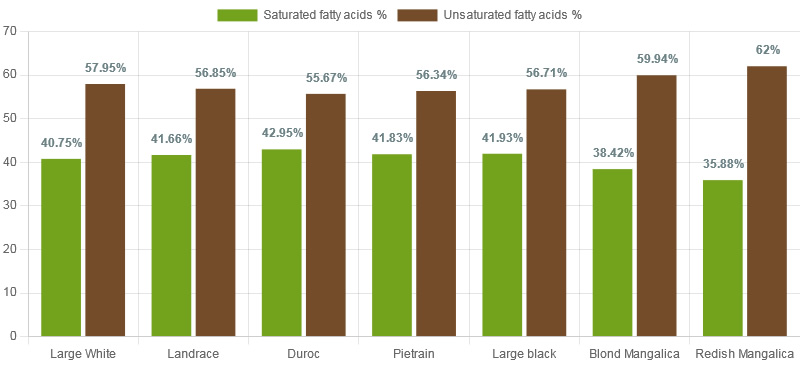


Appreciate the article. Happened to watch the movie Pig staring Nicolas Cage which peaked my interest in this certain breed of pigs.
Excellent article. We are raising 3 of the M pigs. They are interesting to say the least. Big personality.
We are planning on putting one in the freezer and breed two of them. Was told to not use any meat as food. Thank you for the article.
Hi Steven,
I’m glad the article was helpful and informative for you.
However, I didn’t quite understand what you meant by “was told to not use any meat as food”. Am I missing something?
Their meat is awesome…. a few years ago I visited a farm in Hungary where they were raising about 150 Mangalica pigs, and I got to try some of the products they made there. The meat and the lard were absolutely amazing. So, I’m not sure who told you not to eat the meat! 😄
Referring to feeding meat to the m pigs
Oh, now I understand. I was thinking of something completely different. 😂